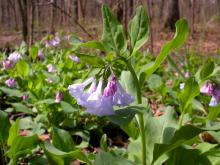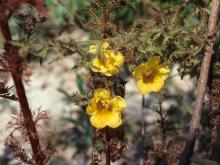Wildflowers, Grasses and Other Nonwoody Plants
Media

Species Types
Scientific Name
Podophyllum peltatum
Description
Mayapple is a common spring wildflower that makes its biggest impression with its leaves, which resemble umbrellas arising from a single stalk. It often grows in colonies.
Media

Species Types
Scientific Name
Ranunculus hispidus
Description
Hispid buttercup is a densely hairy plant with showy yellow flowers. It is found mostly in the southern half of Missouri, usually in moist locations.
Media

Species Types
Scientific Name
Perilla frutescens
Description
Introduced as an ornamental, beefsteak plant is native to Asia. It is common in moist or dry wooded bottomlands, open valley pastures, and along trails, railroads, and roadsides. It spreads invasively in our state.
Media

Species Types
Scientific Name
Uvularia grandiflora
Description
A common spring wildflower found in forests nearly statewide, large bellwort has bell-shaped flowers that droop downward. The yellow petals sometimes look twisted, almost wilted.
Media

Species Types
Scientific Name
Mertensia virginica
Description
One of our most stunning early spring wildflowers, bluebells is also a popular native plant for gardening. As with all native plant gardening, make sure you get your plants from ethical sources.
Media

Species Types
Scientific Name
Cirsium altissimum
Description
Tall thistle is a native thistle that can grow to be 10 feet tall! To identify it, notice its leaves, which are unlobed (though they may be wavy or have only shallow, broad lobes), are felty-hairy beneath, and have prickles only along the edges.
Media

Species Types
Scientific Name
Hibiscus lasiocarpos
Description
Hibiscus in Missouri? You bet! Hairy rose mallow is a native perennial whose 6-inch-wide blossoms look a lot like those of its tropical relatives. The stalks can get woody and can grow to 8 feet tall.
Media

Species Types
Scientific Name
Impatiens capensis
Description
Many Missouri children learn about this orange-flowered native plant by playing with the juicy green seedpods, which, when ripe, "explode" upon the slightest touch. This is jewelweed's mechanism for seed dispersal, and it's the reason for the name "touch-me-not."
Media

Species Types
Scientific Name
Aureolaria pectinata (formerly Gerardia pedicularia)
Description
There are 3 species of Aureolaria in Missouri. Only combleaf yellow false foxglove is annual, has fernlike, delicately dissected leaves, and glandular hairs. It occurs in the Ozarks.
Media

Species Types
Scientific Name
Ludwigia peploides
Description
Water primrose is a common shoreline plant with bright yellow flowers and long, trailing stems. It grows in dense mats in the shallow areas of ponds, lakes, and streams.
See Also
About Wildflowers, Grasses and Other Nonwoody Plants in Missouri
A very simple way of thinking about the green world is to divide the vascular plants into two groups: woody and nonwoody (or herbaceous). But this is an artificial division; many plant families include some species that are woody and some that are not. The diversity of nonwoody vascular plants is staggering! Think of all the ferns, grasses, sedges, lilies, peas, sunflowers, nightshades, milkweeds, mustards, mints, and mallows — weeds and wildflowers — and many more!





















